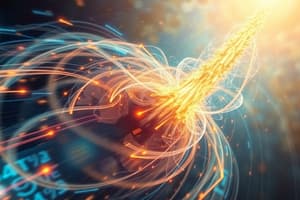Podcast
Questions and Answers
A rocket taking off experiences an action-reaction pair. Which statement accurately describes this interaction, according to Newton's Third Law?
A rocket taking off experiences an action-reaction pair. Which statement accurately describes this interaction, according to Newton's Third Law?
- The rocket pushing down on the fuel exhaust (action) and the fuel exhaust pushing up on the rocket (reaction) are unequal in magnitude.
- The rocket pushing down on the fuel exhaust is the action, while the rocket accelerating upwards is the reaction.
- The rocket pushing down on the fuel exhaust is the action, while the Earth pulling down on the rocket is the reaction.
- The rocket pushing down on the fuel exhaust (action) and the fuel exhaust pushing up on the rocket (reaction) are equal in magnitude and opposite in direction. (correct)
According to Newton's Second Law, how does increasing the mass of an object influence its acceleration if the net force acting upon it remains constant?
According to Newton's Second Law, how does increasing the mass of an object influence its acceleration if the net force acting upon it remains constant?
- Acceleration decreases proportionally. (correct)
- Acceleration remains constant.
- Acceleration increases exponentially.
- Acceleration increases proportionally.
In the Apollo 13 mission, astronauts were pushed back into their seats as the ship accelerated forward. Which of Newton's Laws best explains this phenomenon?
In the Apollo 13 mission, astronauts were pushed back into their seats as the ship accelerated forward. Which of Newton's Laws best explains this phenomenon?
- Newton's Second Law (F=ma)
- Newton's First Law (Law of Inertia) (correct)
- Newton's Law of Universal Gravitation
- Newton's Third Law (Action-Reaction)
An object is in dynamic equilibrium. Which of the following statements must be true?
An object is in dynamic equilibrium. Which of the following statements must be true?
A lab experiment involves pulling a cart with a constant force. If the mass of the cart is doubled, what happens to the acceleration of the cart?
A lab experiment involves pulling a cart with a constant force. If the mass of the cart is doubled, what happens to the acceleration of the cart?
In an experiment exploring Newton's Second Law, the net force on a cart is kept constant while the mass of the cart is varied. Which graph below represents the expected relationship between the cart's mass ($m$) and its acceleration ($a$)?
In an experiment exploring Newton's Second Law, the net force on a cart is kept constant while the mass of the cart is varied. Which graph below represents the expected relationship between the cart's mass ($m$) and its acceleration ($a$)?
When a soccer player kicks a ball, the player's foot applies a force to the ball. According to Newton's Third Law, what is the reaction force?
When a soccer player kicks a ball, the player's foot applies a force to the ball. According to Newton's Third Law, what is the reaction force?
A constant net force is applied to two objects. Object A has a mass of 2kg, and Object B has a mass of 6kg. Which of the following statements is true?
A constant net force is applied to two objects. Object A has a mass of 2kg, and Object B has a mass of 6kg. Which of the following statements is true?
How does inertia affect an object's motion?
How does inertia affect an object's motion?
In a controlled experiment studying Newton's Second Law, a student wants to investigate how the applied force affects the acceleration of a cart while keeping the mass constant. What should the student do to ensure the mass remains constant throughout the experiment?
In a controlled experiment studying Newton's Second Law, a student wants to investigate how the applied force affects the acceleration of a cart while keeping the mass constant. What should the student do to ensure the mass remains constant throughout the experiment?
Flashcards
Static Equilibrium
Static Equilibrium
Forces are balanced and the object is at rest.
Dynamic Equilibrium
Dynamic Equilibrium
Forces are balanced, object is moving at a constant velocity
Newton's First Law
Newton's First Law
Object at rest stays at rest, object in motion stays in motion unless acted on by an unbalanced force
Inertia
Inertia
Signup and view all the flashcards
Newton's Second Law
Newton's Second Law
Signup and view all the flashcards
Newton's Third Law
Newton's Third Law
Signup and view all the flashcards
Increasing mass, constant force
Increasing mass, constant force
Signup and view all the flashcards
Increasing force, constant mass
Increasing force, constant mass
Signup and view all the flashcards
Mass vs Acceleration
Mass vs Acceleration
Signup and view all the flashcards
Force vs Acceleration
Force vs Acceleration
Signup and view all the flashcards
Study Notes
- Newton's Laws involve free body diagrams
- Static equilibrium involves balanced forces and an object at rest
- Dynamic equilibrium involves balanced forces and an object moving at a constant velocity
Newton's First Law
- An object at rest stays at rest, and an object in motion stays in motion (in a straight line at a constant speed) unless acted upon by an unbalanced force
- This is inertia
- Mass determines how much inertia an object has
- Inertia refers to a property of matter that describes an object's resistance to acceleration
- Inertia is not a force
Inertia
- Inertia causes an object in motion to remain in motion and a stationary object to remain stationary
- In space travel objects travel in a straight line unless another force acts upon them
Newton's Second Law
- Fnet = ma - law describes how an object's motion changes when a force is applied to it
- Fg = m * g (g = 9.81 m/s²)
- Free body diagrams can be utilized to find Fnet
- Acceleration shows an inverse relationship with mass
- Acceleration shows an equal relationship with force
Newton's Third Law
- Every action has an equal and opposite reaction
- Action and reaction forces occur in pairs that have equal magnitude and opposite direction
- Examples:
- Soccer player kicks ball forward (action), ball pushes foot backward (reaction)
- Motorboat pushes water backward (action), water pushes motor forward (reaction)
- Rocket Action and Reaction:
- Taking off: Rocket pushes down on the fuel exhaust (action), fuel exhaust pushes up on the rocket (reaction)
- Moving through space: Rocket pushes down on fuel exhaust (action), fuel exhaust pushes up on the rocket (reaction)
Apollo 13 Movie
- The movie follows three astronauts, Jim Lovell, John Swigert, and Fred Haise, who attempted to land on the moon
- They could not land on the moon due to an oxygen tank bursting
- They did a free trajectory return and landed safely
- They were pushed back on their seats because as the ship accelerates forward, and the astronauts accelerate backwards due to inertia (Newton's First Law)
- They accelerate or exert a force when they burn the engine (Newton's Second Law)
- The rocket pushes down on the fuel exhaust, and the fuel exhaust pushes up on the rocket causing the rocket to accelerate away from the Earth (Newton's Third Law)
Newton's Second Law Lab
- This experiment tested how different amounts of mass affected the acceleration of a cart by increasing the amount of mass by 0.5 kg and releasing the cart and seeing how much it's acceleration was
- The independent variable was the mass of the cart (kg)
- The dependent variable was the acceleration of the cart (m/s²)
- The controlled variable was the applied force (about 0.5N - mass hanger plus mass on hanger = 50g)
- The relationship between the mass of the cart and the acceleration of the cart is inverse - as the mass of the cart increases, the acceleration of the cart decreases (y = 0.46/x)
- The relationship between net force and acceleration is linear (Fnet = ma)
- The relationship between m and a is inverse
- The relationship between Fnet and a is linear
- Acceleration of the cart would change if the mass or the net force were increased or decreased
Net Force/Applied Force
- Increase: The acceleration of the cart would increase because a larger force would be acting on it, and acceleration has a direct relationship with force
- Decrease: The acceleration of the cart would decrease because a smaller force would be acting on it, and acceleration has a direct relationship with force
Mass on the Cart
- Increase: The acceleration of the cart would decrease because acceleration has an inverse relationship with mass
- Decrease: The acceleration of the cart would increase because acceleration has an inverse relationship with mass
- If the applied force/controlled variable increased, the inverse curve would move further away from the axis
- If the applied force/controlled variable decreased, the inverse curve would move closer to the axis
Studying That Suits You
Use AI to generate personalized quizzes and flashcards to suit your learning preferences.




